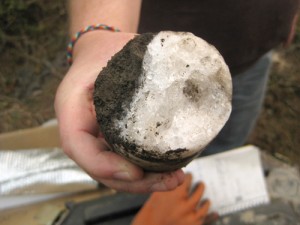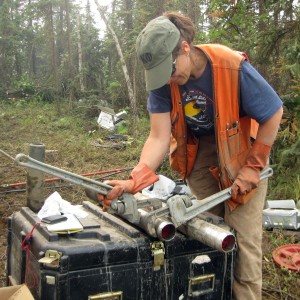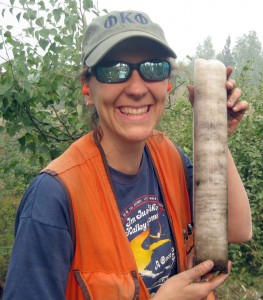Engineering researcher earns NSF CAREER award
April 16, 2012

907-474-6836
4/16/12
University of Alaska Fairbanks researcher Margaret Darrow wants to know how frozen ground reacts to thermal changes in the environment.
What would happen if a gas line was buried in the Arctic’s permafrost-laden soils? How would the soils react? How would climate change affect the ground around the pipe? How would it affect the ground under roads and infrastructure throughout cold regions of the world?
Thanks to an award from the National Science Foundation’s Faculty Early Career Development Program, also known as CAREER, Darrow is set to embark on a five-year study of water that remains liquid at subfreezing temperatures in frozen ground. She hopes her work will lead to better predictions of frost heaving and permafrost’s response to climate change. The research stands to have innumerable applications to construction and planning in Alaska and other circumpolar regions.
“If we can understand this, there are so many directions I could take it,” Darrow said, listing things like frost heaving, landslides in frozen soils, construction of pipelines and bridges and other infrastructure, and planning for roads as a few areas that could benefit from the knowledge she expects to gain. “It plays into all different elements of frozen ground engineering. It is like the nexus.”

During a thaw, the ice melts and oversaturates the soil so it has no strength. It essentially becomes a mush of mud. The collapse of that saturated ground is the final result of frost heave.
While frost heave has been studied extensively in the past, Darrow’s research plan is different because it addresses several factors together. First, she’ll measure the mass and molecular mobility of the unfrozen water using pulsed nuclear magnetic resonance methods. Then she’ll see how those results relate to measurements gathered using other methods, such as CT scanning and X-ray diffraction. Finally she’ll correlate those measurements with measurements related to the charges of the soil particle surfaces.
“We will quantify the unfrozen water content using the NMR method; we will observe the soil in the frozen state at a microscopic level and measure what is going on at the surface of all of these microscopic particles,” Darrow explained.
The measurements will help develop a model based on the relationships between unfrozen water thickness, viscosity and connectivity,
Darrow said. She expects it will provide a more comprehensive picture of frozen soil, including permafrost and its response to changes in climate.

“In many equations and theories used now there is always unfrozen water there but it is not a precise measurement,” she said. “If you change that just a little bit it will have a profound effect on the model results.”
Why does that matter? Think gas pipeline.
If you bury a chilled gas pipeline, the ground will freeze around the pipe. Engineers need to know how that soil will respond, not only to the pipe but also to any potential temperature changes. Since the soil’s response will depend the behavior of the unfrozen water, an accurate model of unfrozen water can help make those predictions, Darrow said.
The project will begin Sept. 1, 2012 and continue for five years. The CAREER award is one of the National Science Foundation’s most prestigious. It recognizes early-career faculty members who exemplify the role of teacher-scholar and strong potential to be leaders in integrating education and research in their fields. Other UAF researchers who have received CAREER awards include: Marvin Schulte, Zhongguo John Ma, William Simpson, Bert Boyer, Hong Liang, Anna Berge and Kristin O’Brien.
ADDITIONAL CONTACTS: Margaret Darrow, assistant professor, at 907-474-7303 or mmdarrow@alaska.edu.
NOTE TO EDITORS: Photos are available for download at www.uafnews.com.
EF/4-16-12/217-12


